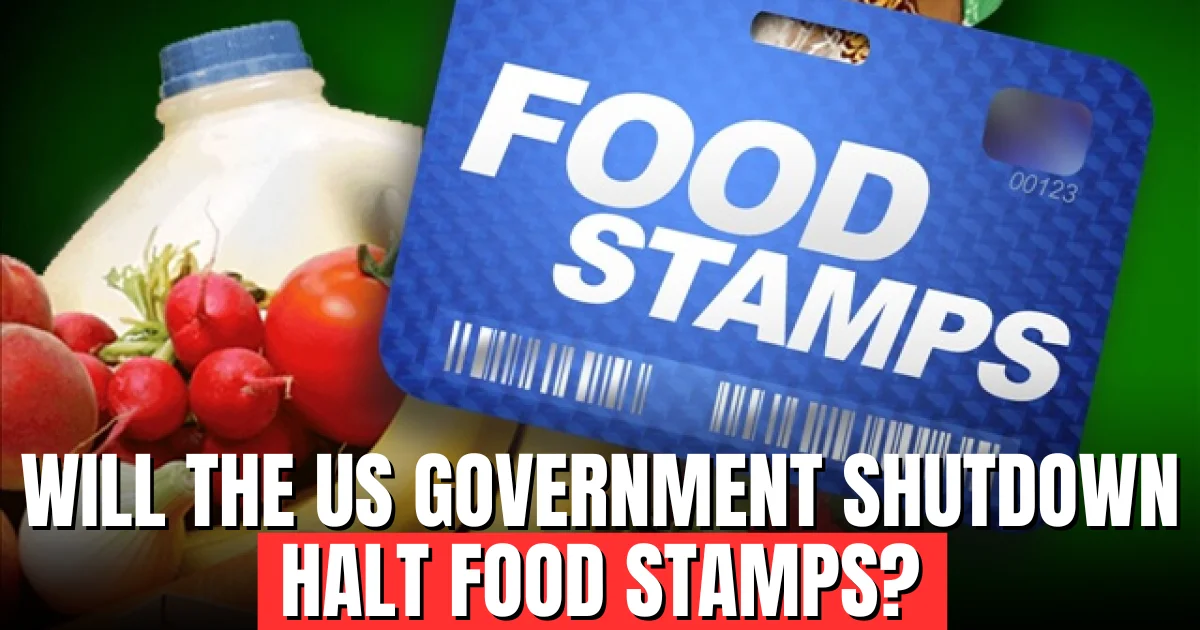Will government shutdown stop food stamps (SNAP)? Benefits safe short-term but at risk if shutdown exceeds 30 days. What recipients need to know now.
Table of Contents
- Quick Answer: What Happens to SNAP
- How SNAP Funding Actually Works
- What Past Shutdowns Taught Us
- Other Food Programs at Risk
- What Recipients Should Do Now
- FAQ
The Short Answer First
If the government shuts down, SNAP benefits (food stamps) will continue—but only temporarily. Here’s what you need to know immediately:
✅ November Benefits: Safe (already funded)
⚠️ December Benefits: Likely safe (30-day funding reserve)
🚨 January 2026 & Beyond: At risk if shutdown extends past 30 days
Current Situation
📅 Shutdown Risk:
- Funding expires: [November 17, 2025 – typical CR deadline]
- Days until deadline: [X] days
- SNAP recipients affected: 41.9 million Americans
- Monthly benefit total: $7.1 billion
Bottom Line: Your benefits are protected short-term, but prolonged shutdown (30+ days) could disrupt payments.
How SNAP Funding Works During Shutdowns
Why SNAP Doesn’t Stop Immediately
Mandatory vs. Discretionary Spending:
🟢 SNAP = Mandatory Spending:
- Authorized by Farm Bill (multi-year legislation)
- Legally required payments (entitlement program)
- Not dependent on annual appropriations
- Similar to Social Security, Medicare
However:
⚠️ Still Requires Operating Funds:
- USDA needs appropriations to process payments
- Staff to run program must be funded
- Technology systems require maintenance
- Without appropriations, eventually stops
The 30-Day Rule
USDA’s Contingency Authority:
📊 Emergency Powers:
- USDA can issue 30 days of benefits during lapse
- Uses previous appropriations authority
- Covers about one month of payments
- After 30 days: No clear legal authority to continue
What This Means:
| Shutdown Length | SNAP Status | Action Required |
|---|---|---|
| 1-7 days | ✅ Normal operations | None |
| 8-30 days | ✅ Benefits continue | Monitor situation |
| 31+ days | 🚨 Benefits at risk | Emergency measures needed |
What USDA Can and Cannot Do
During Shutdown, USDA:
✅ Can Do (Short-Term):
- Issue benefits for current month
- Process existing applications (limited)
- Maintain EBT card system
- Keep fraud prevention systems active
❌ Cannot Do (If Extended):
- Process new applications
- Handle recertifications
- Provide customer service
- Update benefit amounts for changes
- Conduct retailer inspections
Lessons from Past Government Shutdowns
2018-2019: The 35-Day Shutdown
What Happened to SNAP:
📅 Timeline:
- Shutdown began: December 22, 2018
- SNAP concern peaked: Mid-January 2019
- February benefits issued early: January 20, 2019
- Government reopened: January 25, 2019
USDA’s Emergency Action:
⚡ Unprecedented Move:
- USDA issued February 2019 benefits in mid-January
- Gave recipients two months at once
- Prevented immediate crisis
- Created confusion (recipients thought it was January payment)
Problems That Arose:
🚨 Issues:
- Many recipients spent both months’ benefits quickly
- Gap between February early payment and March (when government reopened)
- Benefit timing confusion
- Budget strain on households
💬 SNAP Recipient Testimony (Congressional Hearing):
“I didn’t understand I’d gotten two months at once. When March came, I had nothing and didn’t know why. My kids went hungry.”
2013: 16-Day Shutdown
SNAP Impact:
- Shutdown only 16 days
- Benefits continued normally
- No emergency measures needed
- Minimal recipient impact
Difference:
Shorter duration meant USDA’s 30-day authority covered entire period.
2019 Lesson: The “Double Payment” Problem
What USDA Learned:
If shutdown threatens to extend beyond 30 days:
- Early issuance causes budgeting confusion
- Recipients may not ration properly
- Creates gap later when benefits resume normal schedule
- Better communication essential
2025 Preparation:
USDA reportedly has better contingency plans now:
- Clearer recipient communication
- Staggered issuance if needed
- More emergency funding authority (debated)
Other Nutrition Programs at Greater Risk
WIC: Most Vulnerable
Women, Infants, and Children (WIC):
🚨 High Risk Program:
- 6.7 million participants
- Discretionary spending (not mandatory like SNAP)
- States get monthly grants
- Runs out when state funding depletes (10-20 days typically)
2018-2019 Shutdown:
- Most states had funding for less than 30 days
- Some states issued emergency funds
- Pregnant women, babies at nutritional risk
- Resumed when government reopened
Current Status:
If shutdown occurs, WIC likely disrupted within 2-3 weeks.
School Lunch Programs
National School Lunch Program:
⚠️ Moderate Risk:
- 29.6 million children served daily
- Mix of mandatory and discretionary funding
- USDA has some contingency authority
- States can float costs temporarily
Impact Timeline:
- Week 1-2: Continues normally (contingency funds)
- Week 3-4: State decisions (continue with own funds or reduce service)
- Month 2+: Serious disruptions likely
Food Banks & TEFAP
The Emergency Food Assistance Program:
📦 TEFAP Funding:
- Provides food to food banks
- Discretionary appropriations
- No deliveries during shutdown
- Food banks rely on existing inventory
Compound Effect:
- SNAP reduction fears drive people to food banks
- Food banks can’t get federal commodity shipments
- Private donations critical during shutdown
- Strain on charitable sector
What SNAP Recipients Should Do Now
Immediate Actions
✅ This Week:
- Check Your Balance:
- Know exactly how much you have
- EBT card balance: Check online or call number on card
- Track November benefit deposit date
- Budget Conservatively:
- Assume benefits might be delayed or disrupted
- Stock up on non-perishables if possible
- Don’t spend November benefits all at once
- Update Contact Information:
- Ensure state agency has current phone, email, address
- Sign up for text alerts if available
- Check state SNAP website regularly
- Know Your Resources:
- Locate nearby food banks (FeedingAmerica.org)
- Identify community meal programs
- Research emergency assistance options
If Shutdown Occurs
📋 During Shutdown:
Week 1-2:
- Benefits likely continue normally
- Monitor official USDA announcements
- Don’t panic-spend benefits
Week 3-4:
- Watch for USDA emergency issuance announcements
- If benefits issued early, budget carefully
- Reach out to food banks if needed
Month 2+:
- Benefits at serious risk
- Emergency food assistance critical
- Contact local social services
- Community resources essential
Official Information Sources
Trusted Resources:
🌐 Federal:
- USDA FNS: fns.usda.gov/snap
- Benefits.gov: Information on all programs
- USDA Hotline: 1-800-221-5689
🌐 State:
- Your state SNAP agency (varies by state)
- State 211 helpline (dial 211 for services)
🌐 Advocacy:
- Center on Budget & Policy Priorities: cbpp.org
- Food Research & Action Center: frac.org
Warning: Avoid scam sites claiming to provide emergency benefits or asking for personal information.
The Bigger Picture
Who Depends on SNAP
📊 SNAP Demographics (2025):
| Category | Percentage | Number |
|---|---|---|
| Children | 40% | 16.8 million |
| Elderly (60+) | 12% | 5.0 million |
| Disabled | 20% | 8.4 million |
| Working families | 35% | 14.7 million |
Economic Reality:
- Average benefit: $169 per person/month
- Many recipients also work (wages too low)
- Benefits often exhausted mid-month
- No savings buffer for disruptions
Economic Consequences
💰 Shutdown Impact Beyond Recipients:
Grocery Stores:
- SNAP accounts for 10% of grocery sales nationally
- Up to 40% in some low-income areas
- Retailers lose revenue during disruptions
Local Economies:
- $1 in SNAP generates 1.50−1.50−1.80 in economic activity
- Benefit cuts = reduced consumer spending
- Disproportionate impact on rural areas
Healthcare:
- Food insecurity increases medical costs
- Emergency room visits rise
- Chronic disease management suffers
Political Stakes
Blame Game Preview:
If shutdown affects SNAP:
- Democrats: “Republicans starving children”
- Republicans: “Democrats playing politics with food”
- Reality: Both parties must fund government
- Victims: 42 million Americans who need food
Historical Pattern:
Party forcing shutdown typically blamed for consequences, including nutrition program disruptions.
Frequently Asked Questions
Will my November SNAP benefits arrive on time?
Yes. November benefits should not be affected even if shutdown occurs mid-November. USDA has authority to issue current month.
What if the shutdown lasts two months?
If shutdown exceeds 30 days, USDA may issue benefits early (like January 2019) or benefits could be delayed. Watch for official announcements.
Can I apply for SNAP during a shutdown?
You can submit application, but processing will be limited. Applications may not be processed until shutdown ends. Apply anyway to preserve filing date.
Will my EBT card stop working?
No. Even if benefits aren’t loaded, your card remains active. Any balance already on card can be used normally.
What about SNAP recertifications due during shutdown?
Deadlines may be extended automatically. Check with your state agency. Don’t let benefits lapse—complete recertification even if processing delayed.
Are Social Security and SNAP treated the same in shutdowns?
Similar but not identical. Both are mandatory spending, but Social Security has permanent appropriations authority. SNAP has 30-day contingency authority.
Where can I get emergency food if SNAP stops?
- Food banks: FeedingAmerica.org (find locations)
- Community meal programs: Call 211
- Church/charity programs: Local social services
- School meal programs: Many offer community meals
Will Congress let SNAP benefits actually stop?
Historically, no. Even in worst shutdown (2018-19), emergency measures prevented total cutoff. However, first time is always possible.
Conclusion
A government shutdown will not immediately halt SNAP benefits, but extended shutdowns create real risks for America’s 42 million food stamp recipients.
Key Takeaways:
✅ Short shutdown (under 30 days): Benefits continue with minimal disruption
⚠️ Extended shutdown (30+ days): Benefits at risk, emergency measures needed
🚨 Very long shutdown (60+ days): Serious disruptions likely
What You Should Do:
- Don’t panic about immediate benefit loss
- Do prepare for potential disruptions
- Budget carefully with current benefits
- Know your resources (food banks, community programs)
- Stay informed through official sources
- Act now to update contact info and plan
The Reality:
SNAP is too large and too important for Congress to let it completely collapse. Emergency measures will likely prevent total benefit stoppage. But disruptions, delays, and confusion are possible if shutdown extends.
Best Case: Shutdown avoided entirely or resolved quickly—benefits unaffected.
Worst Case: Extended shutdown requires emergency issuance, creating budgeting challenges and gaps.
Most Likely: Short shutdown, benefits continue, recipients experience anxiety but not hunger.
For 42 million Americans, SNAP isn’t a political talking point—it’s next week’s groceries. Whatever happens in Washington, the need to eat doesn’t shut down.
Stay informed, stay prepared, and remember: past shutdowns have always ended. This one will too.

